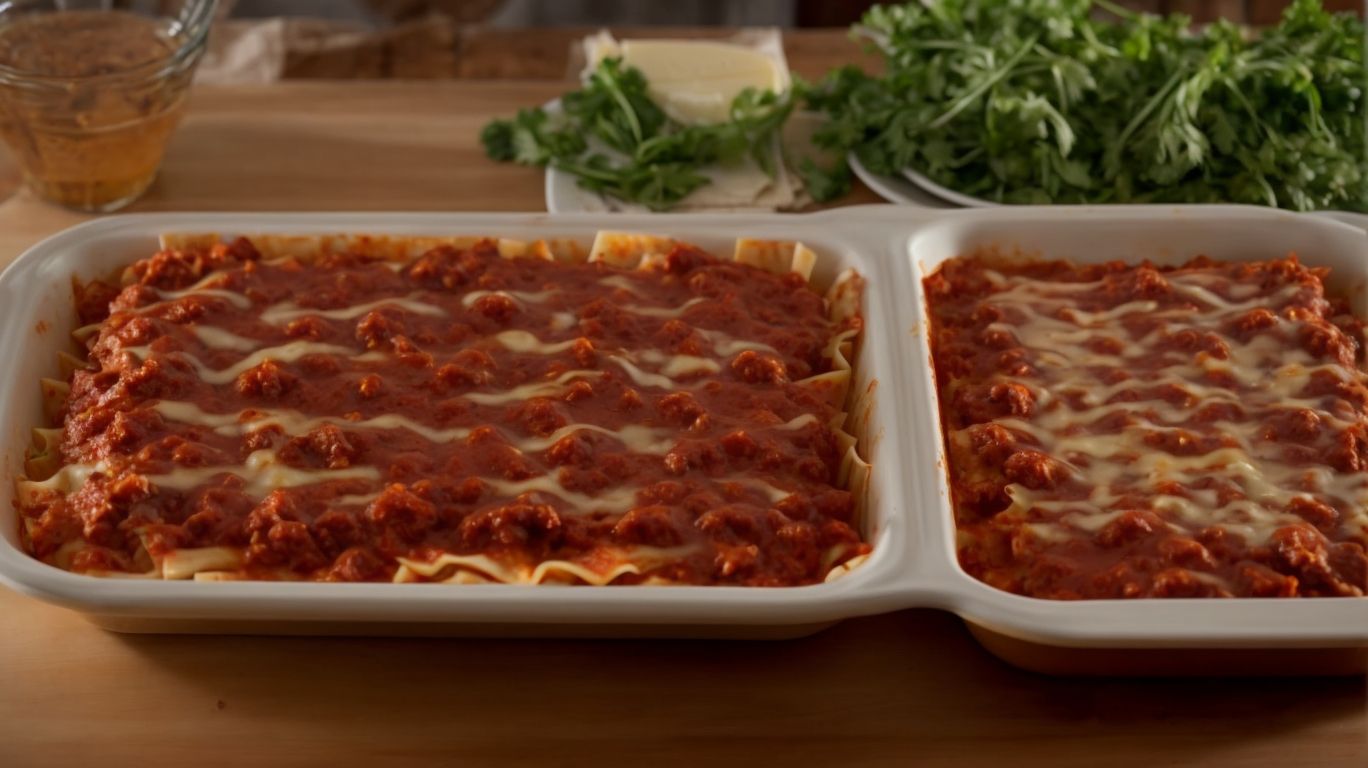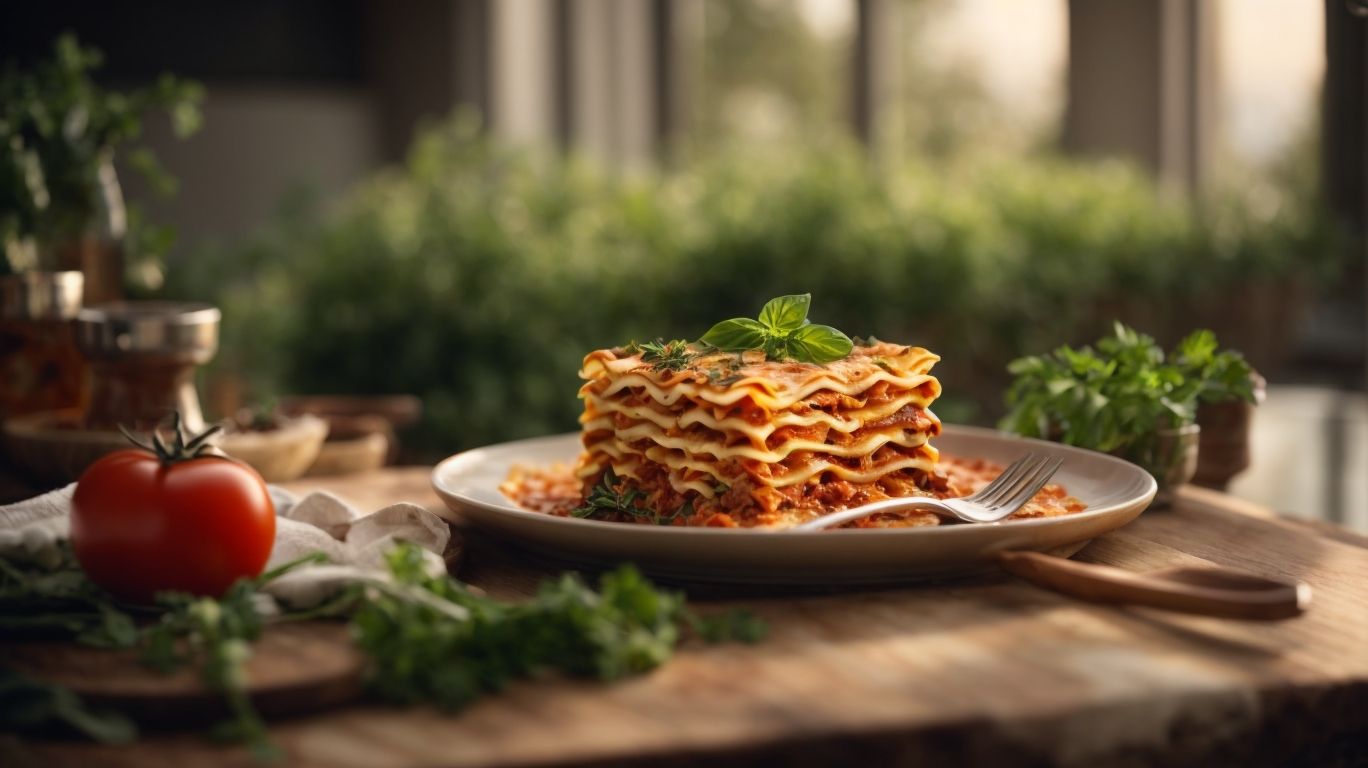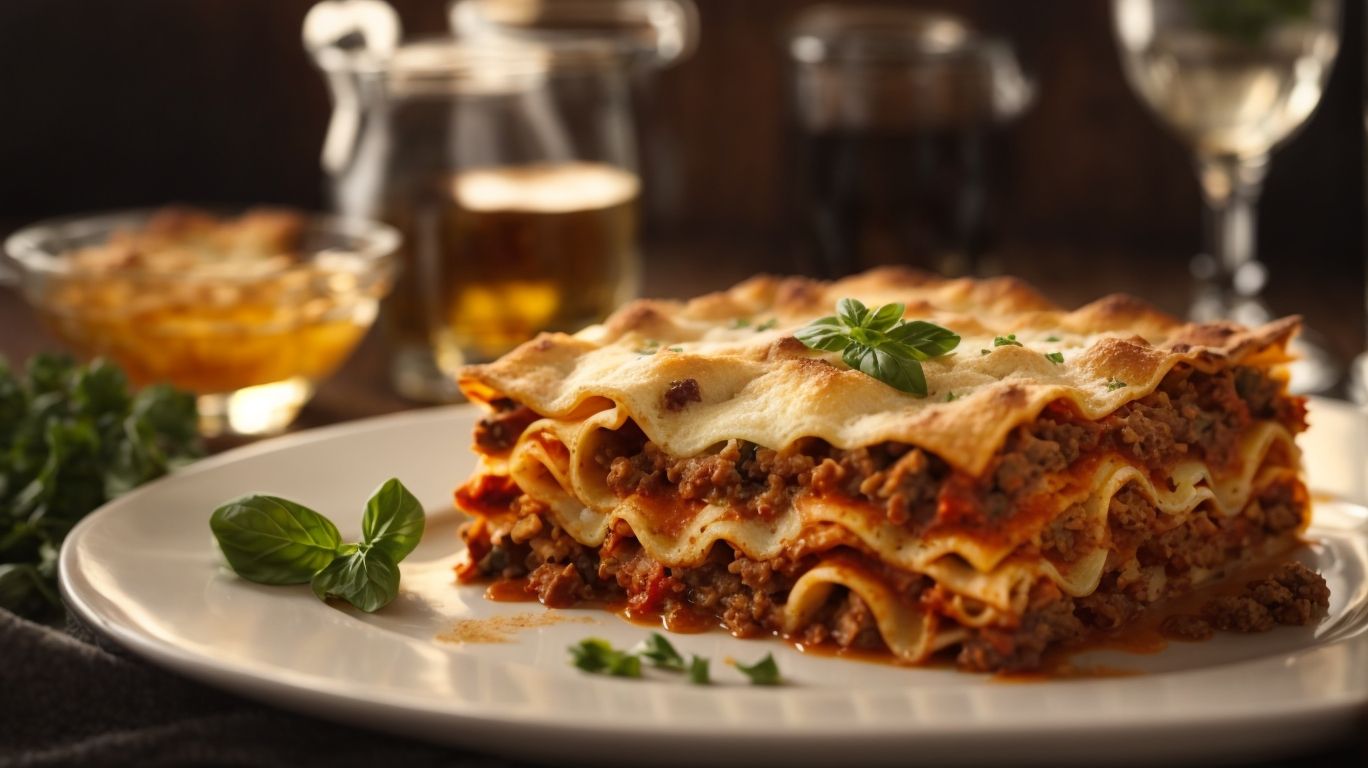How to Bake Lasagna?
Craving a comforting and delicious meal like lasagna but not sure how to make it perfectly every time?
Discover everything you need to know about making the perfect lasagna from scratch in this article. Learn about the ingredients needed, the types of noodles to use, and the step-by-step process of assembling and baking the lasagna.
Impress your family and friends with your culinary skills as we delve into the world of baking lasagna.
Key Takeaways:
What is Lasagna?
Lasagna is a classic Italian dish consisting of layers of pasta, savory meat sauce, creamy cheese, and flavorful seasonings, baked to perfection.
With origins dating back to Ancient Rome, lasagna has evolved over centuries into the beloved comfort food we know today.
The word ‘lasagna’ originally referred to the pot in which the dish was cooked, rather than the actual layered pasta creation we enjoy now.
Traditional lasagna recipes vary across different regions of Italy, with some using a bechamel sauce layer, while others stick to a rich meat ragu for depth of flavor.
This dish not only serves as a hearty meal but also holds cultural significance as a centerpiece at family gatherings and festive occasions.
What are the Ingredients for Lasagna?
To prepare a delicious lasagna, you will need key ingredients such as lasagna noodles, ricotta cheese, ground beef, tomato sauce, garlic, parsley, and a blend of cheeses for the perfect flavor.
Lasagna noodles form the sturdy layers that hold the dish together, while ricotta cheese provides a creamy richness that balances the savory flavors of the ground beef. The tomato sauce adds a tangy sweetness that complements the cheese and meat, while garlic and parsley infuse each bite with aromatic warmth. The blend of cheeses, typically including mozzarella, parmesan, and sometimes provolone, melts into a gooey, decadent topping that crowns the dish with a perfect blend of flavors.
What Types of Lasagna Noodles Can Be Used?
Lasagna noodles are a crucial element in creating the perfect lasagna dish, and you can choose from classic flat noodles or curly edged varieties to add texture and visual appeal.
Regarding cooking lasagna noodles, it’s essential to follow the instructions on the packaging. Boiling the noodles until they are al dente is key, as overcooked noodles can turn mushy when baked in the oven.
Lasagna sheets are versatile and work well with traditional meat or vegetarian lasagna recipes, while lasagna ribbons hold sauce beautifully and are ideal for creamy or white sauce-based variants.
For a gluten-free option, you can opt for brown rice lasagna noodles, which provide a nuttier flavor profile and pair excellently with bold cheeses and hearty fillings.
How to Prepare for Baking Lasagna?
Before baking lasagna, it is essential to layer the ingredients meticulously in a suitable lasagna pan, ensuring each element is evenly distributed for a delicious outcome.
Start by laying down a thin layer of marinara sauce to coat the bottom of the pan, preventing the noodles from sticking. Next, place a layer of lasagna noodles over the sauce, ensuring they slightly overlap. Spread a generous amount of cheese mixture evenly over the noodles, followed by a layer of meat sauce . Repeat these layers until you reach the top of the pan, ending with a final layer of noodles and sauce on top.
Always remember to cover the pan with foil to lock in moisture during baking. The oven should be preheated to the recommended temperature, usually around 375°F to 400°F. Bake the lasagna for around 45-55 minutes, or until the top layer is bubbly and golden brown. Let the lasagna rest for 10-15 minutes after removing it from the oven to allow the layers to set and flavors to meld together perfectly.
Using a high-quality lasagna pan is crucial to ensure even cooking and presentation. Opt for a deep, sturdy pan that can hold all the layers without overflowing. A glass or ceramic pan is ideal for retaining heat and allowing for easier slicing and serving. Remember, the way you layer your ingredients can make all the difference in creating a mouthwatering lasagna that will have everyone coming back for seconds.
What Type of Pan Should Be Used?
Choosing the right lasagna pan is crucial for ensuring even cooking and presentation, whether you opt for a traditional ceramic dish, a disposable aluminum pan for convenience, or a glass baking dish for easy monitoring.
Another popular option is the deep-dish lasagna pan, ideal for making hefty portions and layering ingredients without spillage. These pans often come with taller sides, allowing for multiple layers of noodles, sauce, and cheese.
For those looking for a versatile pan that can go from oven to table, stoneware lasagna pans offer a rustic charm and excellent heat retention. If you prefer non-stick properties for easy cleanup, consider anodized aluminum pans, which ensure little to no food sticking to the surface. Each type of pan has its unique benefits, catering to different cooking preferences.
How to Prepare the Noodles?
Cooking the lasagna noodles to the perfect al dente texture is essential for a successful lasagna dish, ensuring they hold up well during baking and don’t turn mushy.
Start by bringing a large pot of water to a rolling boil, adding a generous pinch of salt to season the water. Carefully add the lasagna noodles one by one, gently stirring to prevent them from sticking together.
Boil the noodles for approximately 8-10 minutes, stirring occasionally to ensure even cooking. Test for doneness by removing a noodle and tasting it; it should be tender with a slight firmness in the center.
Once cooked, drain the noodles in a colander and rinse them under cold water to stop the cooking process and prevent them from sticking.
How to Make the Lasagna Filling?
Creating a flavorful lasagna filling involves combining seasoned meat, rich tomato sauce, aromatic garlic, and fresh herbs to infuse each layer with a depth of taste.
Start by selecting your preferred meat for the filling, such as ground beef, Italian sausage, or a mix of both for added flavor complexity.
Heat a large skillet over medium heat, add a splash of olive oil, and sauté finely chopped onions until they turn translucent.
Add the ground meat to the skillet, using a wooden spoon to break it down into small crumbles as it browns.
Season generously with salt, pepper, Italian seasoning, and a hint of red pepper flakes for a subtle kick.
Introduce minced garlic to the mix, stirring constantly for about a minute until fragrant.
What Type of Meat Can Be Used?
For a hearty lasagna dish, consider using a combination of ground beef and flavorful Italian sausage to add depth of flavor and richness to the meat sauce.
Ground beef provides a robust meaty flavor, while Italian sausage infuses a delicious blend of herbs and spices. The combination of these two meats creates a well-rounded taste profile that complements the layers of pasta and cheese in a lasagna.
To start, brown the ground beef and Italian sausage together in a large skillet until fully cooked. This allows the meats to meld their flavors, enhancing the overall taste of the dish.
When seasoning the meat sauce, consider using a blend of garlic, onion, oregano, and basil for a classic Italian taste. These seasonings elevate the richness of the meats and add a savory depth to the sauce.
How to Make the Tomato Sauce?
Preparing a robust tomato sauce for lasagna involves simmering ripe tomatoes with aromatic garlic, fresh parsley, and a blend of seasonings for a burst of Italian flavors.
Once you have gathered all your ingredients, proceed by sautéing finely chopped onions in olive oil until they turn translucent, adding a subtle sweetness to the sauce.
- Tip: Make sure to use ripe, juicy tomatoes for a rich and full-flavored sauce. San Marzano tomatoes are a popular choice for their sweet yet tangy essence.
- Next, dice the tomatoes and add them to the pot along with a pinch of sugar to balance out the acidity, enhancing the overall taste.
- Let the sauce simmer gently on low heat, allowing the flavors to meld together, creating a luscious, thick consistency.
Adjust the seasoning by sprinkling salt and pepper to taste, and if desired, add a hint of red pepper flakes for a subtle kick.
How to Assemble the Lasagna?

Credits: Poormet.Com – Frank Roberts
Assembling a lasagna involves layering cooked noodles with the meat sauce, cheese mixture, and additional ingredients in a repetitive pattern to create a harmonious blend of flavors and textures.
For the perfect lasagna, start by spreading a thin layer of meat sauce at the bottom of the baking dish to prevent the noodles from sticking. Next, place a layer of cooked noodles evenly over the sauce, followed by a generous sprinkle of the cheese mixture.
- Continue the layering process by adding another layer of meat sauce, ensuring to spread it evenly over the cheese layer.
- On top of the meat sauce, sprinkle a layer of additional ingredients such as vegetables or herbs to add extra depth to the flavors.
What is the Layering Technique for Lasagna?
The key to perfect lasagna layering is to start with a base of sauce, followed by a layer of noodles, cheese mixture, and repeat, ensuring each layer is evenly spread for a delicious outcome.
To achieve that rich, flavorful lasagna, ensure the bottom of the dish is lightly coated with a thin layer of sauce before placing the first set of noodles. Each noodle layer should slightly overlap, creating a sturdy base for the other ingredients.
Ensuring the cheese mixture is evenly spread will yield a creamy and gooey texture that complements the savory sauce and tender noodles.
Remember to drizzle additional sauce over each cheese layer to infuse flavors throughout the dish, and repeat the process until reaching the top, finishing with a generous sprinkle of cheese for that golden, bubbly crust.
How to Add Cheese to the Lasagna?
Incorporating a decadent cheese mixture between lasagna layers adds a creamy texture and rich flavor, typically combining ricotta, Parmesan, and mozzarella for a delightful cheesy experience.
Each of these cheeses contributes its unique properties to the lasagna dish. Ricotta, with its smooth texture, is perfect for adding creaminess. Parmesan enhances the savory depth with its sharp and nutty flavor, while mozzarella melts beautifully, creating that classic stringy cheese pull.
To achieve a gooey, golden-brown cheese topping, it’s essential to layer the cheeses strategically. Alternating thin layers of the melted cheeses with sauce helps distribute them evenly, resulting in a luscious and cohesive blend of flavors.
How to Bake Lasagna?

Credits: Poormet.Com – Tyler Carter
Baking lasagna to perfection requires setting the ideal temperature, covering the dish with foil to prevent burning, and allowing enough time for the flavors to meld together beautifully.
Preheat your oven to 375°F for that perfect balance of cooking through without drying out the dish. Once assembled in your preferred pan, cover the lasagna with a layer of foil before placing it in the oven. This step ensures that the cheese and top layer do not crisp too quickly, allowing the inside to cook evenly. Remember to remove the foil during the last 15-20 minutes of baking to achieve a golden, bubbly crust on top.
What is the Ideal Temperature and Time for Baking Lasagna?
Baking lasagna at an ideal temperature of 375°F (190°C) for approximately 45-60 minutes ensures that the dish cooks evenly, allowing the flavors to meld while creating a golden crust on top.
Temperature control is crucial when baking lasagna to guarantee that the noodles cook through without becoming mushy or underdone. By maintaining the recommended temperature, the dish bakes to perfection, with the cheese bubbling and the sauce melding harmoniously.
The specified timing helps to achieve that desirable balance between a fully cooked interior and a crispy, caramelized top layer. Consistency in following the temperature guidelines and duration leads to a Lasagna masterpiece that delights the taste buds of everyone lucky enough to partake.
How to Check if the Lasagna is Ready?
To determine if the lasagna is ready, insert a knife into the center of the dish; if it comes out hot and clean, the lasagna is cooked through, and the cheese is melted to perfection.
Another way to check the readiness of lasagna is by observing the top layer; it should be golden brown and slightly crispy, indicating a well-baked dish. The edges of the lasagna should be bubbling with the sauce simmering, ensuring that the heat has penetrated the layers. To further confirm doneness, use a food thermometer to check that the internal temperature reaches 165°F (74°C) to guarantee that the meat or any other protein included is properly cooked. This multi-step approach will help you create a delectable and fully cooked lasagna every time!
How to Serve and Store Lasagna?
When serving lasagna, allow it to rest for a few minutes after baking to set, then slice into generous portions and pair with garlic bread, Caesar salad, or Italian greens for a complete meal experience.
For a classic touch, consider topping the lasagna with fresh basil leaves or a sprinkle of Parmesan cheese before serving. Regarding portioning, a typical serving size is about one to two large slices per person, depending on appetite and accompanying sides. Leftovers can be stored in an airtight container in the refrigerator for up to 3-4 days.
To reheat, place individual slices in the oven at a low temperature to prevent drying out, or gently warm them in the microwave for a quick meal. Alternatively, freeze any extra portions for longer-term storage, ensuring proper wrapping to prevent freezer burn.
Frequently Asked Questions
What ingredients do I need to bake lasagna?
To bake lasagna, you will need lasagna noodles, meat sauce (or vegetarian alternative), ricotta cheese, mozzarella cheese, parmesan cheese, and herbs and spices.
How do I prepare the lasagna noodles for baking?
Start by boiling the lasagna noodles according to the package instructions. Once cooked, drain and rinse them with cold water to prevent them from sticking together.
Can I make a vegetarian version of lasagna?
Yes, you can substitute the meat sauce with a variety of vegetables such as mushrooms, zucchini, and bell peppers. You can also use a vegetarian meat alternative or tofu for protein.
Do I need to pre-cook the lasagna noodles before baking?
No, you do not need to pre-cook the lasagna noodles before baking. Simply follow the instructions on the package and layer the uncooked noodles in your lasagna dish.
How do I prevent my lasagna from becoming too watery?
To prevent your lasagna from becoming too watery, make sure to drain any excess liquid from your meat sauce before layering it in the lasagna. You can also sprinkle a layer of breadcrumbs or flour between the layers to absorb any excess liquid.
How long should I bake lasagna for?
Lasagna should be baked for approximately 45 minutes to an hour at 375°F. Make sure to check the lasagna periodically and adjust the baking time as needed based on your oven and preferences for the level of crispy edges.

